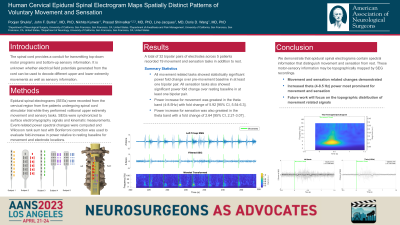Human Cervical Epidural Spinal Electrogram Maps Spatially Distinct Patterns of Voluntary Movement and Sensation
Friday, April 21, 2023


Poojan Shukla (he/him/his)
Medical Student
University of California San Francisco
San Francisco, California, United States
ePoster Presenter(s)
Introduction: The spinal cord provides a conduit for transmitting top-down motor programs and bottom-up sensory information. It is unknown whether electrical field potentials generated from the cord can be used to decode different upper and lower extremity movements as well as sensory information.
Methods: Epidural spinal electrograms (SEGs) were recorded from the cervical region from three patients undergoing a spinal cord stimulator trial for chronic pain during movement and sensory tasks. SEGs were synchronized to surface electromyography signals and kinematic measurements. Event-related power spectral changes were computed and Wilcoxon rank sum test with Bonferroni correction was used to evaluate fold-increase in power relative to resting baseline for movement and electrode locations.
Results: We found SEGs recorded from the cervical spinal cord to demonstrate spatially distinct movement-related increases in delta (2-4 Hz) and theta frequency bands (4-8 Hz) during volitional movement compared to baseline (fold-increase movement vs. baseline: 12.18 [7.34-14.53] for delta, 6.71 [4.52-7.77] for theta). Modest movement-related increases were also seen in the alpha (8-15Hz, 3.59 [2.99-3.88]), beta (15-30Hz, 2.31 [2.13-2.48]) and gamma (30-100Hz, 2.02 [1.90-2.15]) bands. These are different from sensation-related spectral changes which showed increases relative to rest in delta (2.22 [1.42 -3.03]), theta (2.73 [1.95-3.50]), alpha (2.07 [1.73-2.41], beta (1.67 [1.46-1.88]), and gamma (1.97 [1.69-2.25]). Evaluation of electrode pairs revealed statistically significant increases in power for at least one movement in 17/19 electrodes for delta, 16/19 for theta, 18/19 for alpha, 18/19 for beta, and 16/19 for gamma. During sensation, significant increases in power were seen for 10/19 pairs in delta, 5/19 in theta, 6/19 in alpha, 5/19 for beta, and 5/19 for gamma. The spectral changes are tuned to spinal level and side of movement.
Conclusion : We demonstrate that epidural spinal electrograms contain spectral information that distinguish movement and sensation. These motor-sensory information can be topographically mapped by SEG recordings.
Methods: Epidural spinal electrograms (SEGs) were recorded from the cervical region from three patients undergoing a spinal cord stimulator trial for chronic pain during movement and sensory tasks. SEGs were synchronized to surface electromyography signals and kinematic measurements. Event-related power spectral changes were computed and Wilcoxon rank sum test with Bonferroni correction was used to evaluate fold-increase in power relative to resting baseline for movement and electrode locations.
Results: We found SEGs recorded from the cervical spinal cord to demonstrate spatially distinct movement-related increases in delta (2-4 Hz) and theta frequency bands (4-8 Hz) during volitional movement compared to baseline (fold-increase movement vs. baseline: 12.18 [7.34-14.53] for delta, 6.71 [4.52-7.77] for theta). Modest movement-related increases were also seen in the alpha (8-15Hz, 3.59 [2.99-3.88]), beta (15-30Hz, 2.31 [2.13-2.48]) and gamma (30-100Hz, 2.02 [1.90-2.15]) bands. These are different from sensation-related spectral changes which showed increases relative to rest in delta (2.22 [1.42 -3.03]), theta (2.73 [1.95-3.50]), alpha (2.07 [1.73-2.41], beta (1.67 [1.46-1.88]), and gamma (1.97 [1.69-2.25]). Evaluation of electrode pairs revealed statistically significant increases in power for at least one movement in 17/19 electrodes for delta, 16/19 for theta, 18/19 for alpha, 18/19 for beta, and 16/19 for gamma. During sensation, significant increases in power were seen for 10/19 pairs in delta, 5/19 in theta, 6/19 in alpha, 5/19 for beta, and 5/19 for gamma. The spectral changes are tuned to spinal level and side of movement.
Conclusion : We demonstrate that epidural spinal electrograms contain spectral information that distinguish movement and sensation. These motor-sensory information can be topographically mapped by SEG recordings.
